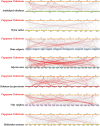Genome-wide identification, phylogeny, evolutionary expansion and expression analyses of bZIP transcription factor family in tartaty buckwheat
- PMID: 31185893
- PMCID: PMC6560858
- DOI: 10.1186/s12864-019-5882-z
Genome-wide identification, phylogeny, evolutionary expansion and expression analyses of bZIP transcription factor family in tartaty buckwheat
Abstract
Background: In reported plants, the bZIP family is one of the largest transcription factor families. bZIP genes play roles in the light signal, seed maturation, flower development, cell elongation, seed accumulation protein, abiotic and biological stress and other biological processes. While, no detailed identification and genome-wide analysis of bZIP family genes in Fagopyum talaricum (tartary buckwheat) has previously been published. The recently reported genome sequence of tartary buckwheat provides theoretical basis for us to study and discuss the characteristics and expression of bZIP genes in tartary buckwheat based on the whole genome.
Results: In this study, 96 FtbZIP genes named from FtbZIP1 to FtbZIP96 were identified and divided into 11 subfamilies according to their genetic relationship with 70 bZIPs of A. thaliana. FtbZIP genes are not evenly distributed on the chromosomes, and we found tandem and segmental duplication events of FtbZIP genes on 8 tartary buckwheat chromosomes. According to the results of gene and motif composition, FtbZIP located in the same group contained analogous intron/exon organizations and motif composition. By qRT-PCR, we quantified the expression of FtbZIP members in stem, root, leaf, fruit, and flower and during fruit development. Exogenous ABA treatment increased the weight of tartary buckwheat fruit and changed the expressions of FtbZIP genes in group A.
Conclusions: Through our study, we identified 96 FtbZIP genes in tartary buckwheat and synthetically further analyzed the structure composition, evolution analysis and expression pattern of FtbZIP proteins. The expression pattern indicates that FtbZIP is important in the course of plant growth and development of tartary buckwheat. Through comprehensively analyzing fruit weight and FtbZIP genes expression after ABA treatment and endogenous ABA content of tartary buckwheat fruit, ABA may regulate downstream gene expression by regulating the expression of FtPinG0003523300.01 and FtPinG0003196200.01, thus indirectly affecting the fruit development of tartary buckwheat. This will help us to further study the function of FtbZIP genes in the tartary buckwheat growth and improve the fruit of tartary buckwheat.
Keywords: ABA; Development; Expression patter; Fruit; FtbZIP; Tartary buckwheat.
Conflict of interest statement
The authors declare that they have no competing interests.
Figures









References
MeSH terms
Substances
Grants and funding
LinkOut - more resources
Full Text Sources

